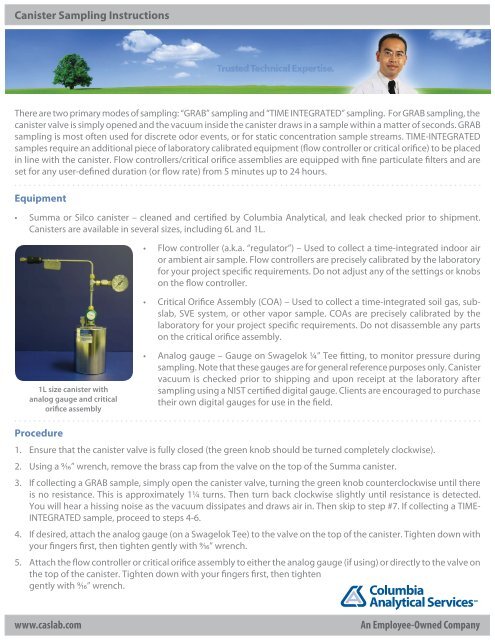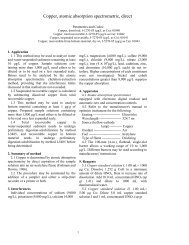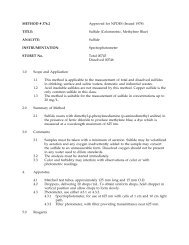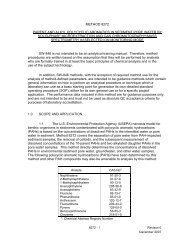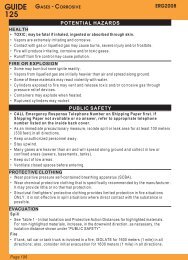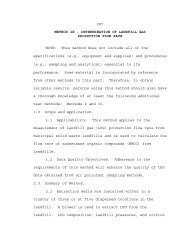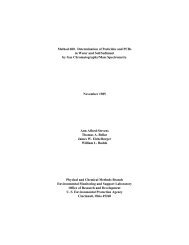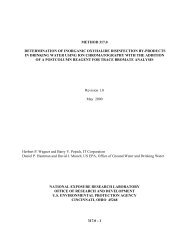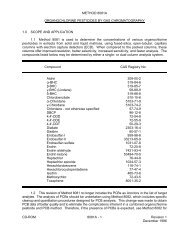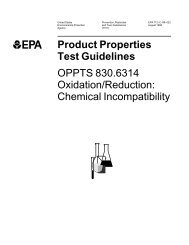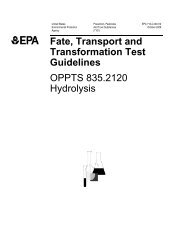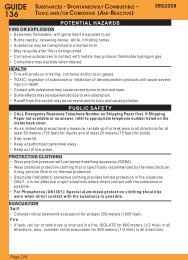Summa Canister Sampling Instructions (PDF) - Columbia Analytical ...
Summa Canister Sampling Instructions (PDF) - Columbia Analytical ...
Summa Canister Sampling Instructions (PDF) - Columbia Analytical ...
Create successful ePaper yourself
Turn your PDF publications into a flip-book with our unique Google optimized e-Paper software.
<strong>Canister</strong> <strong>Sampling</strong> <strong>Instructions</strong>There are two primary modes of sampling: “GRAB” sampling and “TIME INTEGRATED” sampling. For GRAB sampling, thecanister valve is simply opened and the vacuum inside the canister draws in a sample within a matter of seconds. GRABsampling is most often used for discrete odor events, or for static concentration sample streams. TIME-INTEGRATEDsamples require an additional piece of laboratory calibrated equipment (flow controller or critical orifice) to be placedin line with the canister. Flow controllers/critical orifice assemblies are equipped with fine particulate filters and areset for any user-defined duration (or flow rate) from 5 minutes up to 24 hours.Equipment•<strong>Summa</strong> or Silco canister – cleaned and certified by <strong>Columbia</strong> <strong>Analytical</strong>, and leak checked prior to shipment.<strong>Canister</strong>s are available in several sizes, including 6L and 1L.• Flow controller (a.k.a. “regulator”) – Used to collect a time-integrated indoor airor ambient air sample. Flow controllers are precisely calibrated by the laboratoryfor your project specific requirements. Do not adjust any of the settings or knobson the flow controller.• Critical Orifice Assembly (COA) – Used to collect a time-integrated soil gas, subslab,SVE system, or other vapor sample. COAs are precisely calibrated by thelaboratory for your project specific requirements. Do not disassemble any partson the critical orifice assembly.1L size canister withanalog gauge and criticalorifice assembly• Analog gauge – Gauge on Swagelok ¼” Tee fitting, to monitor pressure duringsampling. Note that these gauges are for general reference purposes only. <strong>Canister</strong>vacuum is checked prior to shipping and upon receipt at the laboratory aftersampling using a NIST certified digital gauge. Clients are encouraged to purchasetheir own digital gauges for use in the field.Procedure1.2.3.4.5.Ensure that the canister valve is fully closed (the green knob should be turned completely clockwise).Using a 9/16” wrench, remove the brass cap from the valve on the top of the <strong>Summa</strong> canister.If collecting a GRAB sample, simply open the canister valve, turning the green knob counterclockwise until thereis no resistance. This is approximately 1¼ turns. Then turn back clockwise slightly until resistance is detected.You will hear a hissing noise as the vacuum dissipates and draws air in. Then skip to step #7. If collecting a TIME-INTEGRATED sample, proceed to steps 4-6.If desired, attach the analog gauge (on a Swagelok Tee) to the valve on the top of the canister. Tighten down withyour fingers first, then tighten gently with 9/16” wrench.Attach the flow controller or critical orifice assembly to either the analog gauge (if using) or directly to the valve onthe top of the canister. Tighten down with your fingers first, then tightengently with 9/16” wrench.www.caslab.comAn Employee-Owned Company
6. To open the canister valve, turn the green knob counterclockwise until there is no resistance. This is approximately 1¼ turns. Then turn back clockwise slightly until resistance is detected. Since the flow controller restricts the airflow,you will NOT hear a hissing noise as the vacuum dissipates and draws air in.7. At the end of the sampling period, close the canister valve by turning the green knob clockwise. Do not overtighten.8. Remove the flow controller/critical orifice assembly and/or analog gauge (used for time-integrated sampling only).Wrap both separately in bubble wrap for shipment.9. Replace the brass cap on the canister valve. Tighten it with a 9/16” wrench.10. Label the sample with the tag provided, then attach the tag to the canister with theplastic tie.11. Complete a chain of custody form. Note the canister ID number on the COC. For timeintegratedsampling, note the flow controller or critical orifice assembly identificationnumber with the corresponding canister.12. Place the chain of custody form, the bubble-wrapped flow controller, and the canisterback into the original boxes in which they were shipped to you.Important Notes• Care must be used with the canister valves. DO NOT OVER-TIGHTEN THE VALVES. Handtighten only, do not use tools.• Flow controllers must be securely wrapped in bubble wrap for shipping.• The canister valve fitting is a ¼” male Swagelok fitting.6L size canister with analog• The inlet side of the flow controller is a 1/8” outer diameter.gauge and flow controller• The inlet side of the critical orifice assembly is ¼” outer diameter. A stainless steel ¼”nut with rubber ferrule will be provided to attach sample point tubing to critical orifice assembly.• Do not remove the bar code or serial number labels from the canisters.• Do not make any markings directly on the canister or affix any labels.• 6L size canisters will be tagged as either “AMBIENT” (blue tag) or “SOURCE” (orange tag). AMBIENT canisters shouldbe used for indoor or ambient air sampling. SOURCE canisters should be used for sub-slab, soil vapor, SVE systemmonitoring, landfill gas, source testing, or other types of samples. Please call the laboratory with any questionsregarding the segregation of canisters.• Flow controllers are calibrated such that some residual vacuum should remain after sampling. Please call thelaboratory with any questions regarding pressures of canisters before or after sampling.• Please call the laboratory with any questions regarding proper shipping of canisters.Contact Information2655 Park Center Drive, Ste. ASimi Valley, California 93065805.526.7161805.526.7270 (fax)www.caslab.comAn Employee-Owned Company


